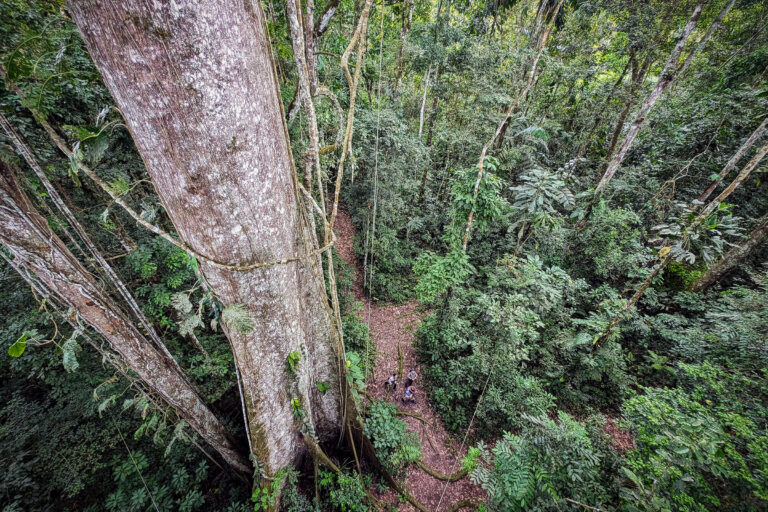- The Congolese giant toad (Sclerophrys channingi) is the first toad found to mimic a harmful snake, in this case the highly venomous Gaboon viper (Bitis gabonica), which has longer fangs and produces more venom than any other known snake species.
- A team of researchers who spent ten years in the field observing the Congolese giant toad and its mimicry behavior published their findings in the Journal of Natural History this week.
- The triangular shape of the toad’s body, its particularly smooth skin for a toad, and its patterns of colors cause the amphibian to look like the viper’s head. In other words, the two are visually similar enough that any predators looking for a meal might certainly be wise to skip right past the Congolese giant toad rather than risk a lethal bite from a Gaboon viper. But just for a little extra insurance, the Congolese giant toad goes even further than mere visual mimicry.
Scientists say they’ve discovered the first-known instance of an amphibian mimicking a venomous snake to deter would-be predators.
There are a number of examples of harmless animals impersonating harmful or noxious animals, known as “Batesian mimicry.” The term refers to Henry Walter Bates, who collected hundreds of species of butterflies in the Amazon in the mid-19th century and discovered that there are many non-toxic butterflies that imitate toxic species. Since then, scientists have found lizards that mimic toxic millipedes, sharks that emulate venomous sea snakes, and harmless snakes, caterpillars, and legless lizards that are capable of passing themselves off as venomous snakes.
But the Congolese giant toad (Sclerophrys channingi) is the first toad found to mimic a harmful snake, in this case the highly venomous Gaboon viper (Bitis gabonica), which has longer fangs and produces more venom than any other known snake species.
A team of researchers who spent ten years in the field observing the Congolese giant toad and its mimicry behavior published their findings in the Journal of Natural History this week.
“We’re convinced that this is an example of Batesian mimicry, where a harmless species avoids predators by pretending to be a dangerous or toxic one,” study co-author Eli Greenbaum of the University of Texas at El Paso said in a statement.

Fully testing this hypothesis would require demonstrating that predators are actually duped by the toad’s mimicry, which would be very difficult to do in the wild because encounters with the toads are rare. But, Greenbaum added, “based on multiple sources of evidence provided in our study, we are confident that our mimicry hypothesis is well-supported.”
The researchers used live specimens caught in the wild, captive specimens, and preserved specimens from museums to compare the toad and viper. They determined that the triangular shape of the toad’s body, its particularly smooth skin for a toad, and its patterns of colors — tan back, dark brown flanks, and two dark brown spots and a dark brown stripe its back — cause the amphibian to look like the viper’s head. In other words, the two are visually similar enough that any predators looking for a meal might certainly be wise to skip right past the Congolese giant toad rather than risk a lethal bite from a Gaboon viper.
But just for a little extra insurance, the Congolese giant toad goes even further than mere visual mimicry. When threatened, Gaboon vipers are known to incline their heads and let loose with a long warning hiss before striking a would-be predator. Chifundera Kusamba, a herpetologist with the Democratic Republic of Congo’s Centre de Recherche en Sciences Naturelles and a co-author of the study, personally observed the toad making a similar hissing noise. The toads have also been known to perform a “bow display,” where its front limbs aren’t used to prop up its body, giving it an appearance similar to a snake cocking its head and preparing to strike.

None of this mimicry on the toad’s part would matter, however, if local predators in its central African rainforest habitat weren’t conditioned to avoid Gaboon vipers, which are found throughout central, eastern, and southern Africa. A comparison of the geographical distribution of the Congolese giant toad and the Gaboon viper in the Democratic Republic of Congo found significant overlap and revealed that the toad seems not to be present in areas where the viper does not occur, the researchers said.
What’s more, the Congolese giant toad and Gaboon viper both first evolved around the same time in the early Pliocene Epoch, about 4 to 5 million years ago. Given their similar appearances and behaviors, as well as overlapping ranges, it’s likely that the toads and vipers coevolved together, the researchers conclude, further supporting their hypothesis that the toads evolved to mimic the vipers as a survival strategy.
“Given the relatively large size and therefore calorific value of this toad compared to other species, it would make tempting prey to a large variety of generalist predators, including primates and other mammals, lizards, snakes and birds,” Kusamba said. “Many of these predators use vision to find their prey, and because the viper is deadly venomous, they probably recognise the distinctive, contrasting markings from a considerable distance and avoid the toad because of them, receiving a threatening hiss if the appearance doesn’t put them off.”

CITATION
• Vaughan, E. R., Teshera, M. S., Kusamba, C., Edmonston, T. R., & Greenbaum, E. (2019). A remarkable example of suspected Batesian mimicry of Gaboon Vipers (Reptilia: Viperidae: Bitis gabonica) by Congolese Giant Toads (Amphibia: Bufonidae: Sclerophrys channingi). Journal of Natural History, 53(29-30), 1853-1871. doi:10.1080/00222933.2019.1669730
FEEDBACK: Use this form to send a message to the author of this post. If you want to post a public comment, you can do that at the bottom of the page.














